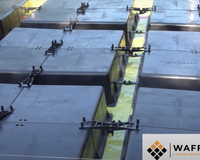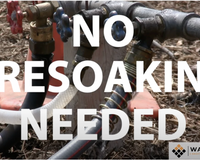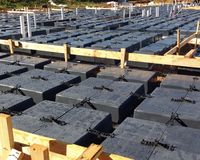In the construction industry, the tasks of over-excavating, re-compacting, and presoaking foundation pads in preparation for building utilize more water than any other part of the building cycle. However, with the Wafflemat foundation system, no presoaking is necessary, saving thousands of gallons of water per home during the construction process.
Largest Use of Water During Building
In the construction industry, the tasks of over-excavating, re-compacting, and presoaking foundation pads in preparation for building utilize more water than any other part of the building cycle. This is especially true when structures are constructed on expansive soils. Before any type of foundation system can be implemented, thousands of gallons of water are used to cause pre-swelling of the soils, with the idea that further expansion pressures on the new foundation will be minimized.
The following shows the volume of water used to presoak building pads in preparation for construction of typical-sized, basic rectangle-shaped foundations of new single-family homes on expansive soils.

Note: Table numbers assume existing soils already contain 17% moisture and must be brought to 35% to attain saturation and cause necessary expansion (Lindberg).
In addition, geotechnical engineers commonly require that presoaking extend five feet beyond actual pad perimeters in all directions to ensure the entire pad area is covered. The net effect increases the area soaked between approx. 1.6 and 1.9 times the foundation size shown in the table.
Finally, and although the table depicts construction of new single-family residences, presoaking must also be done on pads for multi-family and commercial structures. In these cases, and because of larger foundation loads, presoaking is often done to greater depths and even more water used.
According to building industry statistics, the average-sized foundation for a single-family residence in the Western USA today is approx. 1,500 SF for production builders and 3,000 SF for custom builders. Geotechnical engineers typically require 18” presoaking when foundations are constructed in areas of expansive soils, and up to 30” where the lack of water is more pronounced (it is well-noted that industries such as agriculture are quickly depleting underground aquifers, causing land subsidence -- Subsidence reduces the pore space volume between soil grains, resulting in a permanent loss of groundwater storage capacity. Land subsidence in California’s Central Valley, as monitored by the US Geological Survey since the 1950s, exceeds 30 ft. over large areas after agricultural pumping reduced the ground water table elevation by over 300 feet. USGS estimates have some areas sinking one foot per year).
This means it is common, just in preparation of a building pad with 18” of presoaking, to use more than 8,800 gallons of water for the average-sized production home, and more than 15,000 gallons for the average-sized custom home. For a 100-home development by a production builder, those numbers skyrocket to nearly a million gallons – without even accounting for additional usage due to evaporation.
The Wafflemat Foundation-Forming System: No Presoaking Required
A Wafflemat slab is created by connecting a series of “Waffleboxes,” 8½”x19”x19” thermal-grade heat-resistant plastic forms set directly on a leveled subgrade. A monolithically-poured post tensioned or mild-reinforced concrete top slab (usually 4” to 5” thick) is then installed. No other footings are required. The monolithic pour creates concrete beams, in both directions, running throughout the footprint. The completed mat sits on the ground like a raft, the void areas underneath the top slab formed by the placement of the Waffleboxes allowing for expansive soil heave.
Because of its geometry, Wafflemat possesses great stiffness that resists differential swelling resulting from landscaping practices (especially tree-watering), improper surface drainage, or flooding from any source. It does not require presoaking the underlying soils, and since the top of a Wafflemat is typically 12.5” – 13.5” above grade and is itself a capillary break, it requires no gravel, sand, or moisture barrier.
Other Areas of Water Use in the Construction Process and Wafflemat
In addition to presoaking, two other areas in the construction process use significantly-measurable amounts of water: the making of concrete and the wash-out of mixing trucks.
First, quality concrete with a water/cement ratio of 0.45 generally contains between 29 to 33 gallons of water per cubic yard. Strength and durability decreases as water exceeds these amounts, and specifying the correct amount of water is very important for well-designed mixes.
A 1,500 SF home with either a uniform thickness mat foundation (UTF) of 10” or an in-ground ribbed foundation with a 4” slab and 12” x 24” beams evenly spaced throughout utilizes approximately 58 yards of concrete in their construction. This means, with 29 gallons of water used per cy of concrete, nearly 1,700 gallons are necessary to produce the needed amount of material.
In contrast, a Wafflemat slab of similar strength utilizes 35 cy of concrete, and 1,000 gallons of water.
Second, according to Ecology Water Quality Program’s “Concrete Area Wash-Out Best Practices,” approximately 55 gallons of water are needed to clean a ready-mix truck. As an average full truckload contains about 10 cy of concrete, six trucks and over 300 gallons of wash-out water are needed to install a 1,500 SF foundation for either the UTF or in-ground ribbed designs detailed above.
In contrast, four trucks and about 200 gallons are needed for the same 1,500 SF Wafflemat foundation.
Summary
For a 1,500 SF foundation built on expansive soils and requiring 18” of soaking with alternative foundation systems, Wafflemat uses, by comparison, approx. 9,600 gallons less water per home when combining the savings in presoaking, water per cubic yard of concrete, and washout.
In a 100-home development, this would equate to nearly one million gallons of water saved during the construction process.
About Wafflemat
As of January 2019, The Wafflemat foundation-forming system has been installed in over 25,000,000 square feet of residential and light commercial space built across the USA and Mexico since 1995.
The system utilizes less concrete, less reinforcing steel, and reduces excavation of soils and accompanying transport/off haul when compared to other foundation systems designed for use in expansive, rocky, compressible, or liquefiable soils.
Wafflemat can be installed easily, and offers additional savings in building cycletime and future warranty issues. When combined, these areas often deliver hard-dollar savings of 15% - 20% when compared with alternative foundation systems.
Wafflemat Foundations is the source for the most complete information available on the Wafflemat system.
Finally, it is estimated Wafflemat has saved, since its introduction over 25 years ago, more than 100,000,000 gallons of water that would have otherwise been used in the construction process.
To learn more, please visit Wafflemat.com or call 855.923.3628.
Soaking Phases of Expansive Soils

Installation Sequence of Wafflemat Foundation






